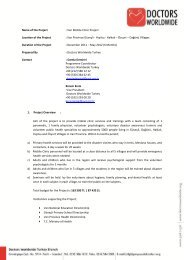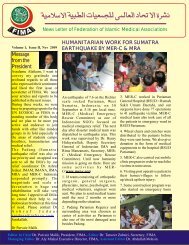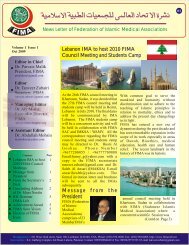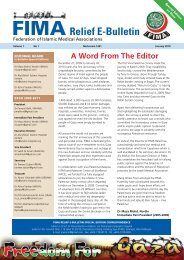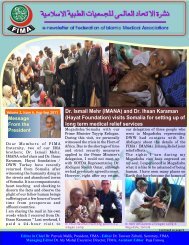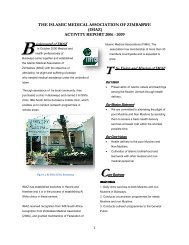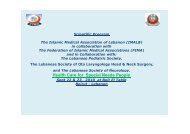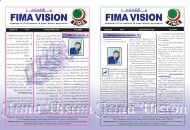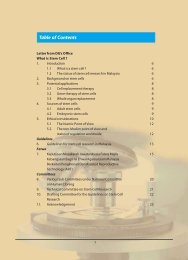FIMA Year Book 2009 - Federation of Islamic Medical Associations
FIMA Year Book 2009 - Federation of Islamic Medical Associations
FIMA Year Book 2009 - Federation of Islamic Medical Associations
You also want an ePaper? Increase the reach of your titles
YUMPU automatically turns print PDFs into web optimized ePapers that Google loves.
Muslim ContributionsEducation and Research will share their findings and recommendationswith all the participating institutions and associations in a conferenceformat. The aim <strong>of</strong> this part <strong>of</strong> exercise is clearly stated above. At the end<strong>of</strong> this activity, all the participating institutions and associations will leavewith a clear documented vision <strong>of</strong> Roles and Goals, evaluation strategiesand academic success measurement tools for the new curricula. Thereby,the key organization will assume a supervisory role, instead <strong>of</strong> theassistance role, in the process <strong>of</strong> striving for excellence in <strong>Islamic</strong> <strong>Medical</strong>Education and Research. The conference should aim to pass a resolution on“Striving for Excellence in <strong>Islamic</strong> Education and Research” to be adoptedby participating institutions.It is proposed that the conference be organised within 3 months <strong>of</strong> theFaculty submitting its report.STEP – 5: Implementing Research and <strong>Islamic</strong> Input into Existing <strong>Medical</strong> Institutions inMuslim Countries.Upon adopting the resolution, participating institutions should aim toimplement the recommendations within 2 years in the entering class (i.e,year 1 students ) in participating institutions. All the participants will beprovided with evaluation strategies and measurement tools for the success<strong>of</strong> new curricula. There are tools available to academicians and managerstoday, that assist in correct evaluation <strong>of</strong> success or failure in variousdomains <strong>of</strong> organizational set ups. Focal concept in healthcare as well asacademic management is “Organizational Capacity” (51) . Organisationalcapacity refers to the organisation’s ability to take effective action, in thiscontext for the purpose <strong>of</strong> continually renewing and improving its healthcarepractices through academic and technological innovation. Absorptive andreceptive capacities are theorized as important antecedents to innovationin healthcare (52) as well as academic excellence. Broadly, the concept <strong>of</strong>absorptive capacity is the organization’s ability to recognise the value <strong>of</strong> newexternal knowledge and to assimilate it, while receptive capacity is the abilityto facilitate the transfer and use <strong>of</strong> new knowledge (53) . Empirical studieshave identified some general antecedent conditions (54,55) , and have testedapplication <strong>of</strong> the concept <strong>of</strong> absorptive capacity to healthcare (55) , althoughreceptive capacities are less well studied. Application <strong>of</strong> these conceptsto purely academic endeavours is even less well studied but proposed onseveral occasions. Empirically supported features <strong>of</strong> organisational contextthat impact on absorptive and receptive capacities in healthcare includeprocesses for identifying, interpreting, and sharing new knowledge; alearning organisation culture; network structures; strong leadership, vision,and management; and supportive technologies (55,56) .Organizational Capacity for our purpose can be divided into 4 wellresearched and valid categories, borrowed from management sciences.<strong>FIMA</strong> <strong>Year</strong><strong>Book</strong> <strong>2009</strong>122




